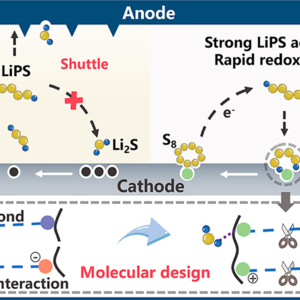Regulating the Molecular Interactions in Polymer Binder for High-Performance Lithium–Sulfur Batteries
Citation
Qi Gong, Lei Hou, Tianyu Li, Yucong Jiao*, and Peiyi Wu*. Regulating the Molecular Interactions in Polymer Binder for High-Performance Lithium–Sulfur Batteries. ACS Nano 2022, 16, 8449-8460.
Abstract
Polymer binders have been shown to efficiently conquer the notorious lithium polysulfide (LiPS) shuttle effects in lithium–sulfur (Li–S) batteries for years, but more study is needed. Herein, a water dispersible and molecular interaction regulated polymer binder (PNAVS) for Li–S batteries was elaborately designed by co-polymerizing N-acryloyl glycinamide and 3-(1-vinyl-3-imidazolio)propanesulfonate. We demonstrate that by modulating the multiple interactions between the functional groups through copolymerization the binder was able to coordinate the LiPSs with higher binding energy for shuttle effect alleviation and cycling performance improvement. In addition, the Li+ diffusion coefficient is also optimized in the PNAVS binder, which facilitates acceleration of the redox kinetics during cycling. Consequently, the PNAVS binder renders the Li–S battery with an ultrastable open circuit voltage for more than 3000 h. Even with a high sulfur loading of 11.7 mg cm–2, the battery can still exhibit excellent areal capacity of 12.21 mA h cm–2. As proof of concept, a pouch cell was also demonstrated with the stable cycling performance for 110 cycles. The binder engineering strategy in this work will propel the practical applications of high-performance batteries.


